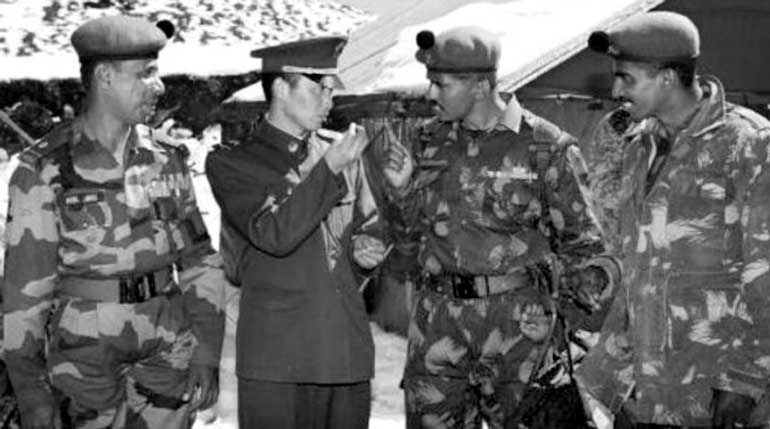Wednesday Mar 12, 2025
Wednesday Mar 12, 2025
Saturday, 15 July 2017 00:02 - - {{hitsCtrl.values.hits}}
In an undisguised bid to humiliate India in the eyes of the rest of South Asia, and reduce its clout in the world at large, China has been trying hard for the past month to provoke India into a short and sharp war, the result of which, it believes, will be a replay of the rout that the Indian army suffered in 1962.
 Indian and Chinese army officers point accusing fingers at each other
Indian and Chinese army officers point accusing fingers at each other
However, right through the series of provocative statements and open threats, India has shown an ancient Indian “yogic stoicism”, remaining unmoved and maintaining silence. Even the normally noisy and belligerent Indian electronic media have kept the coverage at a low key.
One cannot but see the difference between this and India’s belligerent reactions to provocations from Pakistan, a weaker neighbour. India’s forbearance vis-à-vis China could, partly or even substantially, be due to an awareness that it cannot win a shooting war with China, while it can at the very least draw with Pakistan.
China is militarily enormously much stronger than India. It is well entrenched in the Tibetan heights. It is also economically much stronger. It will be able to fight a prolonged war and engage the enemy without seeking outside assistance. On the contrary, India, it is believed, is not in a position to fight for prolonged periods without outside help, both diplomatic and military. It is under-armed and under-manned at the officer level. In the present case, the US will have to stand by India full square to keep the Chinese at bay.
For India, it makes sense not to match China’s brazen threats to promote anti-Indian feelings in Bhutan, Sikkim and the rest of the Indian North East, with counter threats of subversion in Tibet. China’s Tibet is not the same thing as Pakistan’s Balochistan.
 India-China border – Hindustan Times
India-China border – Hindustan Times
Vituperative statements are bound to raise the temperature and lead to war, and India cannot afford a war at this stage when Prime Minister Narendra Modi is still to deliver his election promise to fast track economic development with his “Make in India” project with massive FDIs; given the massive mandate for development which he got in the 2014 elections. Past experience shows that wars, including successful campaigns, tend to bring economic misery to the common man and weaken governments.
The other reason for India holding its horses in the face of daily provocations from China is probably the theory that forbearance will gain world appreciation for being a responsible nation.
Restraint helps
India’s case on the Bhutan-China border and its commitment to honour its treaty with Bhutan will be better appreciated by the comity of nations if it shows restraint, and insists on talks to resolve the issue instead of going to war.
It is perhaps for this reason that the leading lights of the Modi regime, who talked of taking an eye for an eye or a “whole jaw for a tooth” in reacting to an aggressive action by Pakistan, are silent in the face of Chinese belligerence.
Even after China openly questioned the legitimacy of Sikkim’s integration with India and its special relations with Bhutan, Prime Minister Modi did not utter a word of dismay or anger. Instead, he went out of the way to shake hands with Chinese President Xi Jinping at the BRICS meet in Hamburg. Though China cancelled the bilateral talks planned during the summit, the Indian government claimed that the two leaders discussed a “range of issues.” There was no reaction when the Chinese denied the Indian claim.
Playing down severity
More recently, India has been playing down the severity of the barrage of threats from the Chinese, both official and non-official.
Even as the Chinese official spokesman insisted that there could be no talks before the Indians withdraw their troops from the Doklam (or Doka La) area, and suggested that if India insists on sending troops to a disputed area to help out Bhutan, China can very well send troops to disputed Kashmir in aid of Pakistan.
Prior to this, Chinese government-backed scholars and commentators had called upon the Sikkimese and the Bhutanese to throw off the Indian yoke. They accused India of bullying its smaller neighbours. They reminded New Delhi that communities in India’s North-East have a history of rebellion and could revolt against Indian hegemony even now.
Speaking at the Lee Kwan Yew School of Public Policy in Singapore on Tuesday, India’s Foreign Secretary, S. Jaishankar, said that Modi and Xi had agreed at Astana in Kazakhstan on 8 June, that India and China “must not allow differences to become disputes”.
Jaishankar said that differences over terrorism (the banning of Pakistan-based Azhar Masood); nuclear energy access (membership of the Nuclear Suppliers Club); and connectivity initiatives (China’s One Belt One Road project) exist, but none of these should be allowed spoil the totality of the bilateral relationship.
“That the powers in question are civilizational ones, with a positive long history, and a difficult near history, adds to the challenge. India-Sri Lanka relations have acquired so many dimensions and so much substance, that reducing them to black and white augmentation cannot be a serious proposition,” Jaishankar reasoned.He also said that not only the India-China border in Doklam, but the entire stretch of the border of more than 3,000 kms is undefined.
If India flinches in these matters, its credibility as a reliable partner will be badly dented, and that will affect its relations with other countries, especially those in the neighbourhood.It is probable that China might ease the pressure somewhat if India agrees not to oppose Xi‘s OBOR international roads and sea ports project, and not to plot with the US to thwart its economic projects in South Asia.
“It’s a long border you know. No part of the border has been agreed upon on the ground. It is likely that from time to time there are differences along the 3,500 kilometre boundary,” Jaishankar said. This is significant statement in as much as it concedes that the entire India-China border is in dispute.
India’s former National Security Advisor and Foreign Secretary Shivshankar Menon told The Hindu that India-China relations show “stress points” and that it is time the relationship was “recalibrated”; but the recalibration has to be done without bowing to Chinese pressure tactics, he added.
Menon advised India to hold the ground in Dolklam and also its rights in Bhutan which flow from a treaty. If India flinches in these matters, its credibility as a reliable partner will be badly dented, and that will affect its relations with other countries, especially those in the neighbourhood.
Glimmer of hope
Uncharacteristically, Prime Minister Modi has still not spoken or tweeted about the standoff in the border. Neither has President Xi. This generates hope in Indian minds that they are keeping the door open for talks at a convenient time. Modi and Xi will meet at the 9th BRICS summit in Xiamen in China in September. It is hoped that they will break the ice there.
Nevertheless, nobody has any idea as to what the solution might be. Doklam is strategically critical for both India and China. While China wants Bhutan to come over to its side, India fears that the road which the Chinese are constructing in Doklam will help them reach the Siliguri corridor. Once China occupies the corridor, which is a chicken neck, India will lose the only land connection with its troubled and strategically important North Eastern states. With the rise of China and its burgeoning influence over Nepal and Bangladesh, the North-East has become India’s soft underbelly.
However, it is probable that China might ease the pressure somewhat if India agrees not to oppose Xi‘s OBOR international roads and sea ports project, and not to plot with the US to thwart its economic projects in South Asia.
India will find these conditions difficult to meet because its self-respect demands that it enjoys primacy in South Asia – its backyard. India also fees that it has to control the Indian Ocean and that it cannot allow it to become a Chinese lake, bristling with their submarines. This is the reason why this time, the “Malabar” naval exercise with the US and Japanese navies, had anti-submarine warfare as its main theme.
Guest Column

By P.K. Balachandran
Discover Kapruka, the leading online shopping platform in Sri Lanka, where you can conveniently send Gifts and Flowers to your loved ones for any event including Valentine ’s Day. Explore a wide range of popular Shopping Categories on Kapruka, including Toys, Groceries, Electronics, Birthday Cakes, Fruits, Chocolates, Flower Bouquets, Clothing, Watches, Lingerie, Gift Sets and Jewellery. Also if you’re interested in selling with Kapruka, Partner Central by Kapruka is the best solution to start with. Moreover, through Kapruka Global Shop, you can also enjoy the convenience of purchasing products from renowned platforms like Amazon and eBay and have them delivered to Sri Lanka.
Discover Kapruka, the leading online shopping platform in Sri Lanka, where you can conveniently send Gifts and Flowers to your loved ones for any event including Valentine ’s Day. Explore a wide range of popular Shopping Categories on Kapruka, including Toys, Groceries, Electronics, Birthday Cakes, Fruits, Chocolates, Flower Bouquets, Clothing, Watches, Lingerie, Gift Sets and Jewellery. Also if you’re interested in selling with Kapruka, Partner Central by Kapruka is the best solution to start with. Moreover, through Kapruka Global Shop, you can also enjoy the convenience of purchasing products from renowned platforms like Amazon and eBay and have them delivered to Sri Lanka.